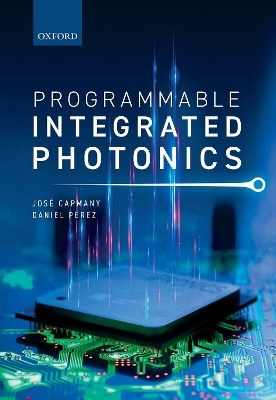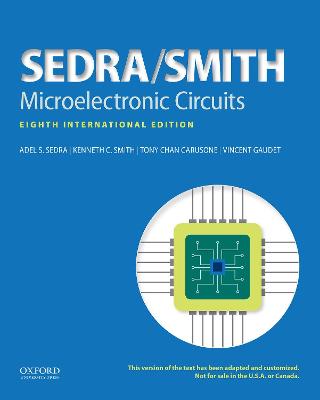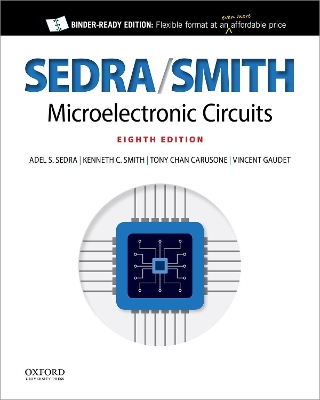VLSI Design
 -10%
portes grátis
-10%
portes grátis
VLSI Design
Das, Debaprasad
OUP India
12/2015
660
Mole
Inglês
9780198094869
15 a 20 dias
788
Descrição não disponível.
Preface
Preface to the First Edition
List of Colour Plates
1 Introduction to VLSI Systems
1.1 Historical Perspective
1.2 Introduction to IC Technology
1.3 Types of Integrated Circuits
1.4 Design Methodology
1.5 Design DomainsY-Chart
1.6 Hierarchical Abstraction
1.7 Design Flow
1.8 Design Styles
1.9 Computer-aided Design
1.10 CMOS Integrated Circuit
1.11 Issues with Integrated Circuits at the DSM Level
1.12 Modelling and Simulation
1.13 Design Metrics
1.14 Cost of Integrated Circuits
1.15 CAD Tools for VLSI Design
1.16 VLSI Design using Computer-aided Design Tools
1.17 Problems in VLSI CAD Domain
1.18 IC Chip IndustryA Brief Outlook
1.19 Recent Developments and Future Projections
2 MOS Transistors
2.1 Introduction to Semiconductor Devices
2.2 Charge Carriers in Semiconductors
2.3 Parallel Plate Capacitor
2.4 MOS Capacitor
2.5 MOS Transistor
2.6 MOSFET Threshold Voltage
2.7 MOSFET Current Equation
2.8 MOSFET V-I Characteristics
2.9 MOSFET Scaling
2.10 Small Geometry Effects
2.11 MOSFET Capacitances
2.12 MOSFET Modelling
3 MOS Inverters
3.1 Introduction
3.2 Voltage Transfer Characteristics
3.3 Resistive Load Inverter
3.4 Enhancement-type nMOS Load Inverter
3.5 Depletion-type nMOS Load Inverter
3.6 CMOS Inverter
3.7 Design of Symmetric Inverter
3.8 Transient Analysis of CMOS Inverter
3.9 Power Supply Voltage Scaling in CMOS Inverter
4 Standard Cell Library Design and Characterization
4.1 Introduction
4.2 Standard Cell Library
4.3 Schematic Design
4.4 Layout Design
4.5 Layout versus Schematic
4.6 Extraction from Layout
4.7 Antenna Effect
4.8 Standard Cell Library Data
4.9 Library Characterization
4.10 Cell Characterization
4.11 Circuit Simulation
4.12 Measuring the Propagation Delay
4.13 Measuring Rise and Fall Time
4.14 Ring Oscillator
4.15 Load/Slew Characterization Table
4.16 Power Characterization
4.17 Reliability and Noise Characterization
4.18 Interconnect Delay Modelling
5 Analog CMOS Design
5.1 Introduction
5.2 MOSFET Small Signal Model
5.3 MOSFET as a Switch
5.4 MOS Diode/Resistor
5.5 Small Signal Analysis of Single Stage Amplifiers
5.6 MOS Current Source and Sink
5.7 Current Mirror
5.8 Resistor Realization Using Switched Capacitor
5.9 MOS Voltage and Current References
5.10 CMOS Amplifier
5.11 MOS Differential Amplifier
5.12 Cascode Amplifier
5.13 Current Amplifier
5.14 Output Amplifier
5.15 Source Follower
5.16 Voltage Level Shifter
5.17 CMOS Operational Amplifier
5.18 Comparator
5.19 Switched Capacitor Filter
5.20 Digital-to-Analog Converter
5.21 Analog-to-Digital Converter
5.22 Phase-locked Loop
5.23 Field Programmable Analog Array
6 Digital CMOS Logic Design
6.1 Introduction
6.2 Digital Logic Design
6.3 CMOS Logic Design
6.4 CMOS Design Methodology
6.5 Design of CMOS Inverter (NOT) Gate
6.6 Design of Two-Input NAND Gate
6.7 Design of Two-Input NOR Gate
6.8 Classification of CMOS Digital Logic Circuit
6.9 Combinational Logic Circuit
6.10 Sequential Logic Circuit
6.11 Pseudo-nMOS Logic
6.12 CMOS Transmission Gate
6.13 Dynamic CMOS Logic
6.14 Domino CMOS Logic
6.15 NORA CMOS Logic
6.16 Zipper CMOS Logic
6.17 True Single-phase Clock (TSPC) Dynamic CMOS Logic
6.18 Pass Transistor Logic
6.19 Complementary Pass Transistor Logic
6.20 Voltage Bootstrapping
6.21 Differential CMOS Logic
6.22 Adiabatic Logic
6.23 Dual-threshold CMOS Logic
7 Semiconductor Memories
7.1 Introduction
7.2 Static RAM
7.3 Dynamic RAM
7.4 Read Only Memory
7.5 Flash Memory
7.6 Content Addressable Memory
7.7 Design of CAM Architecture
8 BiCMOS Technology and Circuits
8.1 Introduction
8.2 Comparison Between CMOS and BJTs
8.3 BiCMOS Technology
8.4 Bipolar Logic
8.5 BiCMOS Logic Circuits
8.6 BiCMOS Two-Inputs NAND Logic
8.7 BiCMOS Two-inputs NOR Logic
8.8 Complex Logic Using BiCMOS
8.9 Applications of BiCMOS Circuits
8.10 Disadvantages of BiCMOS
8.11 SiliconGermanium BiCMOS Technology
9 Logic Synthesis
9.1 Introduction
9.2 Introduction to Synthesis
9.3 Transistor-level or Circuit-level Synthesis
9.4 Logic-level Synthesis
9.5 Block-level Synthesis or Datapath Synthesis
9.6 Logic Synthesis
9.7 Algorithms
9.8 Boolean Space
9.9 Binary Decision Diagram (BDD)
9.10 Logic SynthesisAdvantages and Disadvantages
9.11 How Does It Work?
9.12 Sequential Logic Optimization
9.13 Building Blocks for Logic Design
10 Timing Analysis
10.1 Introduction
10.2 Delay in Any System
10.3 Delay in VLSI Circuits
10.4 Delay in CMOS Inverter
10.5 Slew Balancing
10.6 Transistor Equivalency
10.7 Case Study: Effect of Transistor Size on Propagation Delay
10.8 Design of Two-Inputs NAND Gate for Equal Rise and Fall Slew
10.9 Design of Two-Inputs NOR Gate for Equal Rise and Fall Slew
10.10 MOS Capacitances
10.11 Dependency of Delay and Slew on Power Supply Voltage
10.12 Design Techniques for Delay Reduction
10.13 Intrinsic Delay of Inverter
10.14 Inverter Sizing Effect on Propagation Delay
10.15 Inverter Chain Design
10.16 Effect of Input Slew on Propagation Delay
10.17 Delay Dependence on Input Patterns
10.18 Logical Effort
10.19 Classification of Digital Systems
10.20 Definitions of Timing Terms
10.21 Timing Analysis
10.22 Timing Models
10.23 Timing Analysis Goals
10.24 Timing Analysis at the Chip Level
10.25 Static vs Dynamic Timing Verification
10.26 Factors Impacting Timing Delay
10.27 Static Timing AnalysisCase Study
10.28 Fixed Delay Model
10.29 Checking Timing Constraints
10.30 Timing Verification in Sequential Synchronous Circuits
10.31 Hierarchical Timing Specification and Verification
10.32 Issues with Static Delay Modelling
10.33 First-order Gate Delay Model
10.34 Parasitic Extraction
10.35 Timing Convergence Problem
10.36 Timing-Driven Logic Synthesis
10.37 Gate and Device Sizing
10.38 Typical Delay-area Trade-off
10.39 Timing-driven Layout Synthesis
11 Physical DesignFloorplanning, Placement, and Routing
11.1 Introduction
11.2 Partitioning
11.3 Floorplanning
11.4 Placement
11.5 Routing
11.6 Types Of Routing
11.7 Special Routing
11.8 Multilevel Routing
11.9 Physical Design EDA Tools
11.10 Layout Database
12 Verification and Reliability Analysis
12.1 Introduction
12.2 Verification Methodologies in VLSI Design Flow
12.3 Logic Verification
12.4 Physical Verification
12.5 Design Rule Check
12.6 Layout Versus Schematic (LVS) Check
12.7 Electrical Rule Check
12.8 Antenna Check
12.9 Metal Density Check
12.10 Layout Extraction
12.11 Crosstalk Analysis
12.12 Introduction to Reliability
12.13 IC ReliabilityDefinitions
12.14 Reliability Issues in ICs
12.15 Electromigration
12.16 Time-dependent Dielectric Breakdown
12.17 Channel Hot Electron
12.18 Negative-bias Temperature Instability
12.19 IR Drop
12.20 Latch-up
12.21 Electrical Overstress and Electrostatic Discharge
12.22 Soft Error
13 IC Packaging
13.1 Introduction
13.2 Types of IC Packages
13.3 Package Modelling
13.4 Electrical Package Modelling
13.5 IC Package Thermal Modelling
13.6 IC Package Stress Modelling
13.7 Package Models
13.8 Package Simulation
13.9 Flip-chip Package
14 VLSI Testing
14.1 Introduction
14.2 Importance of Testing
14.3 Fault Models
14.4 Fault Simulation
14.5 Design for Testability
14.6 Ad Hoc Testing
14.7 Scan Test
14.8 Boundary Scan Test
14.9 Built-in Self Test
14.10 Automatic Test-pattern Generation
14.11 IDDQ Test
14.12 Design for Manufacturability (DMF)
14.13 Design Economics
14.14 Yield
14.15 Probe Test
15 Field Programmable Gate Array
15.1 Introduction
15.2 Programmable Logic Devices
15.3 Sequential PLD
15.4 Complex PLD
15.5 Field Programmable Gate Array
15.6 Xilinx SRAM-based FPGA
15.7 Comparison between FPGA, ASIC, and CPLD
15.8 FPGA-based System Design
15.9 IRSIM
15.10 Generalized Open Source Programmable Logic
16 VLSI Process Technology
16.1 Introduction
16.2 Crystal Growth
16.3 Photolithography
16.4 CMOS Technology: n-well and p-well Process
16.5 Oxidation
16.6 Diffusion
16.7 Ion Implantation
16.8 Etching
16.9 Epitaxial Growth
16.10 Metallization
16.11 Packaging
17 Subsystem Design
17.1 Introduction
17.2 Adders
17.3 Multipliers
17.4 Drivers and Buffers
18 Low Power Logic Circuits
18.1 Introduction
18.2 Power Dissipation in Logic Circuits
18.3 Power Reduction Techniques
18.4 Low Power Design Techniques
Appendix A Digital Design Using VHDL
Appendix B Digital Design Using Verilog
Appendix C SPICE Tutorial
Appendix D Answers to Objective-type Questions
Preface to the First Edition
List of Colour Plates
1 Introduction to VLSI Systems
1.1 Historical Perspective
1.2 Introduction to IC Technology
1.3 Types of Integrated Circuits
1.4 Design Methodology
1.5 Design DomainsY-Chart
1.6 Hierarchical Abstraction
1.7 Design Flow
1.8 Design Styles
1.9 Computer-aided Design
1.10 CMOS Integrated Circuit
1.11 Issues with Integrated Circuits at the DSM Level
1.12 Modelling and Simulation
1.13 Design Metrics
1.14 Cost of Integrated Circuits
1.15 CAD Tools for VLSI Design
1.16 VLSI Design using Computer-aided Design Tools
1.17 Problems in VLSI CAD Domain
1.18 IC Chip IndustryA Brief Outlook
1.19 Recent Developments and Future Projections
2 MOS Transistors
2.1 Introduction to Semiconductor Devices
2.2 Charge Carriers in Semiconductors
2.3 Parallel Plate Capacitor
2.4 MOS Capacitor
2.5 MOS Transistor
2.6 MOSFET Threshold Voltage
2.7 MOSFET Current Equation
2.8 MOSFET V-I Characteristics
2.9 MOSFET Scaling
2.10 Small Geometry Effects
2.11 MOSFET Capacitances
2.12 MOSFET Modelling
3 MOS Inverters
3.1 Introduction
3.2 Voltage Transfer Characteristics
3.3 Resistive Load Inverter
3.4 Enhancement-type nMOS Load Inverter
3.5 Depletion-type nMOS Load Inverter
3.6 CMOS Inverter
3.7 Design of Symmetric Inverter
3.8 Transient Analysis of CMOS Inverter
3.9 Power Supply Voltage Scaling in CMOS Inverter
4 Standard Cell Library Design and Characterization
4.1 Introduction
4.2 Standard Cell Library
4.3 Schematic Design
4.4 Layout Design
4.5 Layout versus Schematic
4.6 Extraction from Layout
4.7 Antenna Effect
4.8 Standard Cell Library Data
4.9 Library Characterization
4.10 Cell Characterization
4.11 Circuit Simulation
4.12 Measuring the Propagation Delay
4.13 Measuring Rise and Fall Time
4.14 Ring Oscillator
4.15 Load/Slew Characterization Table
4.16 Power Characterization
4.17 Reliability and Noise Characterization
4.18 Interconnect Delay Modelling
5 Analog CMOS Design
5.1 Introduction
5.2 MOSFET Small Signal Model
5.3 MOSFET as a Switch
5.4 MOS Diode/Resistor
5.5 Small Signal Analysis of Single Stage Amplifiers
5.6 MOS Current Source and Sink
5.7 Current Mirror
5.8 Resistor Realization Using Switched Capacitor
5.9 MOS Voltage and Current References
5.10 CMOS Amplifier
5.11 MOS Differential Amplifier
5.12 Cascode Amplifier
5.13 Current Amplifier
5.14 Output Amplifier
5.15 Source Follower
5.16 Voltage Level Shifter
5.17 CMOS Operational Amplifier
5.18 Comparator
5.19 Switched Capacitor Filter
5.20 Digital-to-Analog Converter
5.21 Analog-to-Digital Converter
5.22 Phase-locked Loop
5.23 Field Programmable Analog Array
6 Digital CMOS Logic Design
6.1 Introduction
6.2 Digital Logic Design
6.3 CMOS Logic Design
6.4 CMOS Design Methodology
6.5 Design of CMOS Inverter (NOT) Gate
6.6 Design of Two-Input NAND Gate
6.7 Design of Two-Input NOR Gate
6.8 Classification of CMOS Digital Logic Circuit
6.9 Combinational Logic Circuit
6.10 Sequential Logic Circuit
6.11 Pseudo-nMOS Logic
6.12 CMOS Transmission Gate
6.13 Dynamic CMOS Logic
6.14 Domino CMOS Logic
6.15 NORA CMOS Logic
6.16 Zipper CMOS Logic
6.17 True Single-phase Clock (TSPC) Dynamic CMOS Logic
6.18 Pass Transistor Logic
6.19 Complementary Pass Transistor Logic
6.20 Voltage Bootstrapping
6.21 Differential CMOS Logic
6.22 Adiabatic Logic
6.23 Dual-threshold CMOS Logic
7 Semiconductor Memories
7.1 Introduction
7.2 Static RAM
7.3 Dynamic RAM
7.4 Read Only Memory
7.5 Flash Memory
7.6 Content Addressable Memory
7.7 Design of CAM Architecture
8 BiCMOS Technology and Circuits
8.1 Introduction
8.2 Comparison Between CMOS and BJTs
8.3 BiCMOS Technology
8.4 Bipolar Logic
8.5 BiCMOS Logic Circuits
8.6 BiCMOS Two-Inputs NAND Logic
8.7 BiCMOS Two-inputs NOR Logic
8.8 Complex Logic Using BiCMOS
8.9 Applications of BiCMOS Circuits
8.10 Disadvantages of BiCMOS
8.11 SiliconGermanium BiCMOS Technology
9 Logic Synthesis
9.1 Introduction
9.2 Introduction to Synthesis
9.3 Transistor-level or Circuit-level Synthesis
9.4 Logic-level Synthesis
9.5 Block-level Synthesis or Datapath Synthesis
9.6 Logic Synthesis
9.7 Algorithms
9.8 Boolean Space
9.9 Binary Decision Diagram (BDD)
9.10 Logic SynthesisAdvantages and Disadvantages
9.11 How Does It Work?
9.12 Sequential Logic Optimization
9.13 Building Blocks for Logic Design
10 Timing Analysis
10.1 Introduction
10.2 Delay in Any System
10.3 Delay in VLSI Circuits
10.4 Delay in CMOS Inverter
10.5 Slew Balancing
10.6 Transistor Equivalency
10.7 Case Study: Effect of Transistor Size on Propagation Delay
10.8 Design of Two-Inputs NAND Gate for Equal Rise and Fall Slew
10.9 Design of Two-Inputs NOR Gate for Equal Rise and Fall Slew
10.10 MOS Capacitances
10.11 Dependency of Delay and Slew on Power Supply Voltage
10.12 Design Techniques for Delay Reduction
10.13 Intrinsic Delay of Inverter
10.14 Inverter Sizing Effect on Propagation Delay
10.15 Inverter Chain Design
10.16 Effect of Input Slew on Propagation Delay
10.17 Delay Dependence on Input Patterns
10.18 Logical Effort
10.19 Classification of Digital Systems
10.20 Definitions of Timing Terms
10.21 Timing Analysis
10.22 Timing Models
10.23 Timing Analysis Goals
10.24 Timing Analysis at the Chip Level
10.25 Static vs Dynamic Timing Verification
10.26 Factors Impacting Timing Delay
10.27 Static Timing AnalysisCase Study
10.28 Fixed Delay Model
10.29 Checking Timing Constraints
10.30 Timing Verification in Sequential Synchronous Circuits
10.31 Hierarchical Timing Specification and Verification
10.32 Issues with Static Delay Modelling
10.33 First-order Gate Delay Model
10.34 Parasitic Extraction
10.35 Timing Convergence Problem
10.36 Timing-Driven Logic Synthesis
10.37 Gate and Device Sizing
10.38 Typical Delay-area Trade-off
10.39 Timing-driven Layout Synthesis
11 Physical DesignFloorplanning, Placement, and Routing
11.1 Introduction
11.2 Partitioning
11.3 Floorplanning
11.4 Placement
11.5 Routing
11.6 Types Of Routing
11.7 Special Routing
11.8 Multilevel Routing
11.9 Physical Design EDA Tools
11.10 Layout Database
12 Verification and Reliability Analysis
12.1 Introduction
12.2 Verification Methodologies in VLSI Design Flow
12.3 Logic Verification
12.4 Physical Verification
12.5 Design Rule Check
12.6 Layout Versus Schematic (LVS) Check
12.7 Electrical Rule Check
12.8 Antenna Check
12.9 Metal Density Check
12.10 Layout Extraction
12.11 Crosstalk Analysis
12.12 Introduction to Reliability
12.13 IC ReliabilityDefinitions
12.14 Reliability Issues in ICs
12.15 Electromigration
12.16 Time-dependent Dielectric Breakdown
12.17 Channel Hot Electron
12.18 Negative-bias Temperature Instability
12.19 IR Drop
12.20 Latch-up
12.21 Electrical Overstress and Electrostatic Discharge
12.22 Soft Error
13 IC Packaging
13.1 Introduction
13.2 Types of IC Packages
13.3 Package Modelling
13.4 Electrical Package Modelling
13.5 IC Package Thermal Modelling
13.6 IC Package Stress Modelling
13.7 Package Models
13.8 Package Simulation
13.9 Flip-chip Package
14 VLSI Testing
14.1 Introduction
14.2 Importance of Testing
14.3 Fault Models
14.4 Fault Simulation
14.5 Design for Testability
14.6 Ad Hoc Testing
14.7 Scan Test
14.8 Boundary Scan Test
14.9 Built-in Self Test
14.10 Automatic Test-pattern Generation
14.11 IDDQ Test
14.12 Design for Manufacturability (DMF)
14.13 Design Economics
14.14 Yield
14.15 Probe Test
15 Field Programmable Gate Array
15.1 Introduction
15.2 Programmable Logic Devices
15.3 Sequential PLD
15.4 Complex PLD
15.5 Field Programmable Gate Array
15.6 Xilinx SRAM-based FPGA
15.7 Comparison between FPGA, ASIC, and CPLD
15.8 FPGA-based System Design
15.9 IRSIM
15.10 Generalized Open Source Programmable Logic
16 VLSI Process Technology
16.1 Introduction
16.2 Crystal Growth
16.3 Photolithography
16.4 CMOS Technology: n-well and p-well Process
16.5 Oxidation
16.6 Diffusion
16.7 Ion Implantation
16.8 Etching
16.9 Epitaxial Growth
16.10 Metallization
16.11 Packaging
17 Subsystem Design
17.1 Introduction
17.2 Adders
17.3 Multipliers
17.4 Drivers and Buffers
18 Low Power Logic Circuits
18.1 Introduction
18.2 Power Dissipation in Logic Circuits
18.3 Power Reduction Techniques
18.4 Low Power Design Techniques
Appendix A Digital Design Using VHDL
Appendix B Digital Design Using Verilog
Appendix C SPICE Tutorial
Appendix D Answers to Objective-type Questions
Este título pertence ao(s) assunto(s) indicados(s). Para ver outros títulos clique no assunto desejado.
Preface
Preface to the First Edition
List of Colour Plates
1 Introduction to VLSI Systems
1.1 Historical Perspective
1.2 Introduction to IC Technology
1.3 Types of Integrated Circuits
1.4 Design Methodology
1.5 Design DomainsY-Chart
1.6 Hierarchical Abstraction
1.7 Design Flow
1.8 Design Styles
1.9 Computer-aided Design
1.10 CMOS Integrated Circuit
1.11 Issues with Integrated Circuits at the DSM Level
1.12 Modelling and Simulation
1.13 Design Metrics
1.14 Cost of Integrated Circuits
1.15 CAD Tools for VLSI Design
1.16 VLSI Design using Computer-aided Design Tools
1.17 Problems in VLSI CAD Domain
1.18 IC Chip IndustryA Brief Outlook
1.19 Recent Developments and Future Projections
2 MOS Transistors
2.1 Introduction to Semiconductor Devices
2.2 Charge Carriers in Semiconductors
2.3 Parallel Plate Capacitor
2.4 MOS Capacitor
2.5 MOS Transistor
2.6 MOSFET Threshold Voltage
2.7 MOSFET Current Equation
2.8 MOSFET V-I Characteristics
2.9 MOSFET Scaling
2.10 Small Geometry Effects
2.11 MOSFET Capacitances
2.12 MOSFET Modelling
3 MOS Inverters
3.1 Introduction
3.2 Voltage Transfer Characteristics
3.3 Resistive Load Inverter
3.4 Enhancement-type nMOS Load Inverter
3.5 Depletion-type nMOS Load Inverter
3.6 CMOS Inverter
3.7 Design of Symmetric Inverter
3.8 Transient Analysis of CMOS Inverter
3.9 Power Supply Voltage Scaling in CMOS Inverter
4 Standard Cell Library Design and Characterization
4.1 Introduction
4.2 Standard Cell Library
4.3 Schematic Design
4.4 Layout Design
4.5 Layout versus Schematic
4.6 Extraction from Layout
4.7 Antenna Effect
4.8 Standard Cell Library Data
4.9 Library Characterization
4.10 Cell Characterization
4.11 Circuit Simulation
4.12 Measuring the Propagation Delay
4.13 Measuring Rise and Fall Time
4.14 Ring Oscillator
4.15 Load/Slew Characterization Table
4.16 Power Characterization
4.17 Reliability and Noise Characterization
4.18 Interconnect Delay Modelling
5 Analog CMOS Design
5.1 Introduction
5.2 MOSFET Small Signal Model
5.3 MOSFET as a Switch
5.4 MOS Diode/Resistor
5.5 Small Signal Analysis of Single Stage Amplifiers
5.6 MOS Current Source and Sink
5.7 Current Mirror
5.8 Resistor Realization Using Switched Capacitor
5.9 MOS Voltage and Current References
5.10 CMOS Amplifier
5.11 MOS Differential Amplifier
5.12 Cascode Amplifier
5.13 Current Amplifier
5.14 Output Amplifier
5.15 Source Follower
5.16 Voltage Level Shifter
5.17 CMOS Operational Amplifier
5.18 Comparator
5.19 Switched Capacitor Filter
5.20 Digital-to-Analog Converter
5.21 Analog-to-Digital Converter
5.22 Phase-locked Loop
5.23 Field Programmable Analog Array
6 Digital CMOS Logic Design
6.1 Introduction
6.2 Digital Logic Design
6.3 CMOS Logic Design
6.4 CMOS Design Methodology
6.5 Design of CMOS Inverter (NOT) Gate
6.6 Design of Two-Input NAND Gate
6.7 Design of Two-Input NOR Gate
6.8 Classification of CMOS Digital Logic Circuit
6.9 Combinational Logic Circuit
6.10 Sequential Logic Circuit
6.11 Pseudo-nMOS Logic
6.12 CMOS Transmission Gate
6.13 Dynamic CMOS Logic
6.14 Domino CMOS Logic
6.15 NORA CMOS Logic
6.16 Zipper CMOS Logic
6.17 True Single-phase Clock (TSPC) Dynamic CMOS Logic
6.18 Pass Transistor Logic
6.19 Complementary Pass Transistor Logic
6.20 Voltage Bootstrapping
6.21 Differential CMOS Logic
6.22 Adiabatic Logic
6.23 Dual-threshold CMOS Logic
7 Semiconductor Memories
7.1 Introduction
7.2 Static RAM
7.3 Dynamic RAM
7.4 Read Only Memory
7.5 Flash Memory
7.6 Content Addressable Memory
7.7 Design of CAM Architecture
8 BiCMOS Technology and Circuits
8.1 Introduction
8.2 Comparison Between CMOS and BJTs
8.3 BiCMOS Technology
8.4 Bipolar Logic
8.5 BiCMOS Logic Circuits
8.6 BiCMOS Two-Inputs NAND Logic
8.7 BiCMOS Two-inputs NOR Logic
8.8 Complex Logic Using BiCMOS
8.9 Applications of BiCMOS Circuits
8.10 Disadvantages of BiCMOS
8.11 SiliconGermanium BiCMOS Technology
9 Logic Synthesis
9.1 Introduction
9.2 Introduction to Synthesis
9.3 Transistor-level or Circuit-level Synthesis
9.4 Logic-level Synthesis
9.5 Block-level Synthesis or Datapath Synthesis
9.6 Logic Synthesis
9.7 Algorithms
9.8 Boolean Space
9.9 Binary Decision Diagram (BDD)
9.10 Logic SynthesisAdvantages and Disadvantages
9.11 How Does It Work?
9.12 Sequential Logic Optimization
9.13 Building Blocks for Logic Design
10 Timing Analysis
10.1 Introduction
10.2 Delay in Any System
10.3 Delay in VLSI Circuits
10.4 Delay in CMOS Inverter
10.5 Slew Balancing
10.6 Transistor Equivalency
10.7 Case Study: Effect of Transistor Size on Propagation Delay
10.8 Design of Two-Inputs NAND Gate for Equal Rise and Fall Slew
10.9 Design of Two-Inputs NOR Gate for Equal Rise and Fall Slew
10.10 MOS Capacitances
10.11 Dependency of Delay and Slew on Power Supply Voltage
10.12 Design Techniques for Delay Reduction
10.13 Intrinsic Delay of Inverter
10.14 Inverter Sizing Effect on Propagation Delay
10.15 Inverter Chain Design
10.16 Effect of Input Slew on Propagation Delay
10.17 Delay Dependence on Input Patterns
10.18 Logical Effort
10.19 Classification of Digital Systems
10.20 Definitions of Timing Terms
10.21 Timing Analysis
10.22 Timing Models
10.23 Timing Analysis Goals
10.24 Timing Analysis at the Chip Level
10.25 Static vs Dynamic Timing Verification
10.26 Factors Impacting Timing Delay
10.27 Static Timing AnalysisCase Study
10.28 Fixed Delay Model
10.29 Checking Timing Constraints
10.30 Timing Verification in Sequential Synchronous Circuits
10.31 Hierarchical Timing Specification and Verification
10.32 Issues with Static Delay Modelling
10.33 First-order Gate Delay Model
10.34 Parasitic Extraction
10.35 Timing Convergence Problem
10.36 Timing-Driven Logic Synthesis
10.37 Gate and Device Sizing
10.38 Typical Delay-area Trade-off
10.39 Timing-driven Layout Synthesis
11 Physical DesignFloorplanning, Placement, and Routing
11.1 Introduction
11.2 Partitioning
11.3 Floorplanning
11.4 Placement
11.5 Routing
11.6 Types Of Routing
11.7 Special Routing
11.8 Multilevel Routing
11.9 Physical Design EDA Tools
11.10 Layout Database
12 Verification and Reliability Analysis
12.1 Introduction
12.2 Verification Methodologies in VLSI Design Flow
12.3 Logic Verification
12.4 Physical Verification
12.5 Design Rule Check
12.6 Layout Versus Schematic (LVS) Check
12.7 Electrical Rule Check
12.8 Antenna Check
12.9 Metal Density Check
12.10 Layout Extraction
12.11 Crosstalk Analysis
12.12 Introduction to Reliability
12.13 IC ReliabilityDefinitions
12.14 Reliability Issues in ICs
12.15 Electromigration
12.16 Time-dependent Dielectric Breakdown
12.17 Channel Hot Electron
12.18 Negative-bias Temperature Instability
12.19 IR Drop
12.20 Latch-up
12.21 Electrical Overstress and Electrostatic Discharge
12.22 Soft Error
13 IC Packaging
13.1 Introduction
13.2 Types of IC Packages
13.3 Package Modelling
13.4 Electrical Package Modelling
13.5 IC Package Thermal Modelling
13.6 IC Package Stress Modelling
13.7 Package Models
13.8 Package Simulation
13.9 Flip-chip Package
14 VLSI Testing
14.1 Introduction
14.2 Importance of Testing
14.3 Fault Models
14.4 Fault Simulation
14.5 Design for Testability
14.6 Ad Hoc Testing
14.7 Scan Test
14.8 Boundary Scan Test
14.9 Built-in Self Test
14.10 Automatic Test-pattern Generation
14.11 IDDQ Test
14.12 Design for Manufacturability (DMF)
14.13 Design Economics
14.14 Yield
14.15 Probe Test
15 Field Programmable Gate Array
15.1 Introduction
15.2 Programmable Logic Devices
15.3 Sequential PLD
15.4 Complex PLD
15.5 Field Programmable Gate Array
15.6 Xilinx SRAM-based FPGA
15.7 Comparison between FPGA, ASIC, and CPLD
15.8 FPGA-based System Design
15.9 IRSIM
15.10 Generalized Open Source Programmable Logic
16 VLSI Process Technology
16.1 Introduction
16.2 Crystal Growth
16.3 Photolithography
16.4 CMOS Technology: n-well and p-well Process
16.5 Oxidation
16.6 Diffusion
16.7 Ion Implantation
16.8 Etching
16.9 Epitaxial Growth
16.10 Metallization
16.11 Packaging
17 Subsystem Design
17.1 Introduction
17.2 Adders
17.3 Multipliers
17.4 Drivers and Buffers
18 Low Power Logic Circuits
18.1 Introduction
18.2 Power Dissipation in Logic Circuits
18.3 Power Reduction Techniques
18.4 Low Power Design Techniques
Appendix A Digital Design Using VHDL
Appendix B Digital Design Using Verilog
Appendix C SPICE Tutorial
Appendix D Answers to Objective-type Questions
Preface to the First Edition
List of Colour Plates
1 Introduction to VLSI Systems
1.1 Historical Perspective
1.2 Introduction to IC Technology
1.3 Types of Integrated Circuits
1.4 Design Methodology
1.5 Design DomainsY-Chart
1.6 Hierarchical Abstraction
1.7 Design Flow
1.8 Design Styles
1.9 Computer-aided Design
1.10 CMOS Integrated Circuit
1.11 Issues with Integrated Circuits at the DSM Level
1.12 Modelling and Simulation
1.13 Design Metrics
1.14 Cost of Integrated Circuits
1.15 CAD Tools for VLSI Design
1.16 VLSI Design using Computer-aided Design Tools
1.17 Problems in VLSI CAD Domain
1.18 IC Chip IndustryA Brief Outlook
1.19 Recent Developments and Future Projections
2 MOS Transistors
2.1 Introduction to Semiconductor Devices
2.2 Charge Carriers in Semiconductors
2.3 Parallel Plate Capacitor
2.4 MOS Capacitor
2.5 MOS Transistor
2.6 MOSFET Threshold Voltage
2.7 MOSFET Current Equation
2.8 MOSFET V-I Characteristics
2.9 MOSFET Scaling
2.10 Small Geometry Effects
2.11 MOSFET Capacitances
2.12 MOSFET Modelling
3 MOS Inverters
3.1 Introduction
3.2 Voltage Transfer Characteristics
3.3 Resistive Load Inverter
3.4 Enhancement-type nMOS Load Inverter
3.5 Depletion-type nMOS Load Inverter
3.6 CMOS Inverter
3.7 Design of Symmetric Inverter
3.8 Transient Analysis of CMOS Inverter
3.9 Power Supply Voltage Scaling in CMOS Inverter
4 Standard Cell Library Design and Characterization
4.1 Introduction
4.2 Standard Cell Library
4.3 Schematic Design
4.4 Layout Design
4.5 Layout versus Schematic
4.6 Extraction from Layout
4.7 Antenna Effect
4.8 Standard Cell Library Data
4.9 Library Characterization
4.10 Cell Characterization
4.11 Circuit Simulation
4.12 Measuring the Propagation Delay
4.13 Measuring Rise and Fall Time
4.14 Ring Oscillator
4.15 Load/Slew Characterization Table
4.16 Power Characterization
4.17 Reliability and Noise Characterization
4.18 Interconnect Delay Modelling
5 Analog CMOS Design
5.1 Introduction
5.2 MOSFET Small Signal Model
5.3 MOSFET as a Switch
5.4 MOS Diode/Resistor
5.5 Small Signal Analysis of Single Stage Amplifiers
5.6 MOS Current Source and Sink
5.7 Current Mirror
5.8 Resistor Realization Using Switched Capacitor
5.9 MOS Voltage and Current References
5.10 CMOS Amplifier
5.11 MOS Differential Amplifier
5.12 Cascode Amplifier
5.13 Current Amplifier
5.14 Output Amplifier
5.15 Source Follower
5.16 Voltage Level Shifter
5.17 CMOS Operational Amplifier
5.18 Comparator
5.19 Switched Capacitor Filter
5.20 Digital-to-Analog Converter
5.21 Analog-to-Digital Converter
5.22 Phase-locked Loop
5.23 Field Programmable Analog Array
6 Digital CMOS Logic Design
6.1 Introduction
6.2 Digital Logic Design
6.3 CMOS Logic Design
6.4 CMOS Design Methodology
6.5 Design of CMOS Inverter (NOT) Gate
6.6 Design of Two-Input NAND Gate
6.7 Design of Two-Input NOR Gate
6.8 Classification of CMOS Digital Logic Circuit
6.9 Combinational Logic Circuit
6.10 Sequential Logic Circuit
6.11 Pseudo-nMOS Logic
6.12 CMOS Transmission Gate
6.13 Dynamic CMOS Logic
6.14 Domino CMOS Logic
6.15 NORA CMOS Logic
6.16 Zipper CMOS Logic
6.17 True Single-phase Clock (TSPC) Dynamic CMOS Logic
6.18 Pass Transistor Logic
6.19 Complementary Pass Transistor Logic
6.20 Voltage Bootstrapping
6.21 Differential CMOS Logic
6.22 Adiabatic Logic
6.23 Dual-threshold CMOS Logic
7 Semiconductor Memories
7.1 Introduction
7.2 Static RAM
7.3 Dynamic RAM
7.4 Read Only Memory
7.5 Flash Memory
7.6 Content Addressable Memory
7.7 Design of CAM Architecture
8 BiCMOS Technology and Circuits
8.1 Introduction
8.2 Comparison Between CMOS and BJTs
8.3 BiCMOS Technology
8.4 Bipolar Logic
8.5 BiCMOS Logic Circuits
8.6 BiCMOS Two-Inputs NAND Logic
8.7 BiCMOS Two-inputs NOR Logic
8.8 Complex Logic Using BiCMOS
8.9 Applications of BiCMOS Circuits
8.10 Disadvantages of BiCMOS
8.11 SiliconGermanium BiCMOS Technology
9 Logic Synthesis
9.1 Introduction
9.2 Introduction to Synthesis
9.3 Transistor-level or Circuit-level Synthesis
9.4 Logic-level Synthesis
9.5 Block-level Synthesis or Datapath Synthesis
9.6 Logic Synthesis
9.7 Algorithms
9.8 Boolean Space
9.9 Binary Decision Diagram (BDD)
9.10 Logic SynthesisAdvantages and Disadvantages
9.11 How Does It Work?
9.12 Sequential Logic Optimization
9.13 Building Blocks for Logic Design
10 Timing Analysis
10.1 Introduction
10.2 Delay in Any System
10.3 Delay in VLSI Circuits
10.4 Delay in CMOS Inverter
10.5 Slew Balancing
10.6 Transistor Equivalency
10.7 Case Study: Effect of Transistor Size on Propagation Delay
10.8 Design of Two-Inputs NAND Gate for Equal Rise and Fall Slew
10.9 Design of Two-Inputs NOR Gate for Equal Rise and Fall Slew
10.10 MOS Capacitances
10.11 Dependency of Delay and Slew on Power Supply Voltage
10.12 Design Techniques for Delay Reduction
10.13 Intrinsic Delay of Inverter
10.14 Inverter Sizing Effect on Propagation Delay
10.15 Inverter Chain Design
10.16 Effect of Input Slew on Propagation Delay
10.17 Delay Dependence on Input Patterns
10.18 Logical Effort
10.19 Classification of Digital Systems
10.20 Definitions of Timing Terms
10.21 Timing Analysis
10.22 Timing Models
10.23 Timing Analysis Goals
10.24 Timing Analysis at the Chip Level
10.25 Static vs Dynamic Timing Verification
10.26 Factors Impacting Timing Delay
10.27 Static Timing AnalysisCase Study
10.28 Fixed Delay Model
10.29 Checking Timing Constraints
10.30 Timing Verification in Sequential Synchronous Circuits
10.31 Hierarchical Timing Specification and Verification
10.32 Issues with Static Delay Modelling
10.33 First-order Gate Delay Model
10.34 Parasitic Extraction
10.35 Timing Convergence Problem
10.36 Timing-Driven Logic Synthesis
10.37 Gate and Device Sizing
10.38 Typical Delay-area Trade-off
10.39 Timing-driven Layout Synthesis
11 Physical DesignFloorplanning, Placement, and Routing
11.1 Introduction
11.2 Partitioning
11.3 Floorplanning
11.4 Placement
11.5 Routing
11.6 Types Of Routing
11.7 Special Routing
11.8 Multilevel Routing
11.9 Physical Design EDA Tools
11.10 Layout Database
12 Verification and Reliability Analysis
12.1 Introduction
12.2 Verification Methodologies in VLSI Design Flow
12.3 Logic Verification
12.4 Physical Verification
12.5 Design Rule Check
12.6 Layout Versus Schematic (LVS) Check
12.7 Electrical Rule Check
12.8 Antenna Check
12.9 Metal Density Check
12.10 Layout Extraction
12.11 Crosstalk Analysis
12.12 Introduction to Reliability
12.13 IC ReliabilityDefinitions
12.14 Reliability Issues in ICs
12.15 Electromigration
12.16 Time-dependent Dielectric Breakdown
12.17 Channel Hot Electron
12.18 Negative-bias Temperature Instability
12.19 IR Drop
12.20 Latch-up
12.21 Electrical Overstress and Electrostatic Discharge
12.22 Soft Error
13 IC Packaging
13.1 Introduction
13.2 Types of IC Packages
13.3 Package Modelling
13.4 Electrical Package Modelling
13.5 IC Package Thermal Modelling
13.6 IC Package Stress Modelling
13.7 Package Models
13.8 Package Simulation
13.9 Flip-chip Package
14 VLSI Testing
14.1 Introduction
14.2 Importance of Testing
14.3 Fault Models
14.4 Fault Simulation
14.5 Design for Testability
14.6 Ad Hoc Testing
14.7 Scan Test
14.8 Boundary Scan Test
14.9 Built-in Self Test
14.10 Automatic Test-pattern Generation
14.11 IDDQ Test
14.12 Design for Manufacturability (DMF)
14.13 Design Economics
14.14 Yield
14.15 Probe Test
15 Field Programmable Gate Array
15.1 Introduction
15.2 Programmable Logic Devices
15.3 Sequential PLD
15.4 Complex PLD
15.5 Field Programmable Gate Array
15.6 Xilinx SRAM-based FPGA
15.7 Comparison between FPGA, ASIC, and CPLD
15.8 FPGA-based System Design
15.9 IRSIM
15.10 Generalized Open Source Programmable Logic
16 VLSI Process Technology
16.1 Introduction
16.2 Crystal Growth
16.3 Photolithography
16.4 CMOS Technology: n-well and p-well Process
16.5 Oxidation
16.6 Diffusion
16.7 Ion Implantation
16.8 Etching
16.9 Epitaxial Growth
16.10 Metallization
16.11 Packaging
17 Subsystem Design
17.1 Introduction
17.2 Adders
17.3 Multipliers
17.4 Drivers and Buffers
18 Low Power Logic Circuits
18.1 Introduction
18.2 Power Dissipation in Logic Circuits
18.3 Power Reduction Techniques
18.4 Low Power Design Techniques
Appendix A Digital Design Using VHDL
Appendix B Digital Design Using Verilog
Appendix C SPICE Tutorial
Appendix D Answers to Objective-type Questions
Este título pertence ao(s) assunto(s) indicados(s). Para ver outros títulos clique no assunto desejado.











